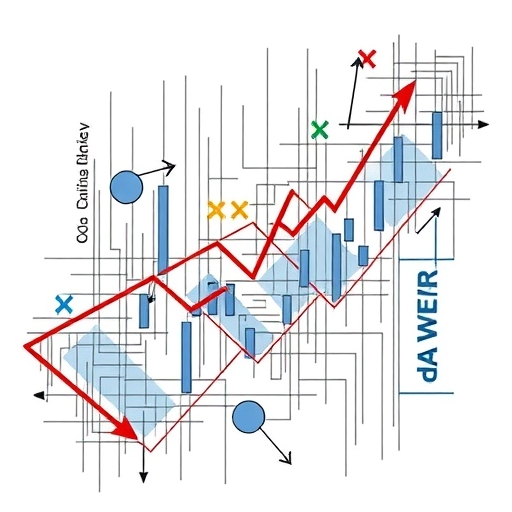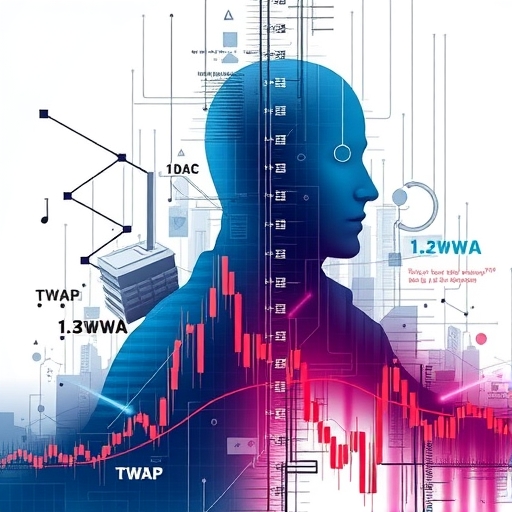Mastering the VWAP Algorithm: Beyond the Benchmark to Intelligent Trading Execution
Welcome, aspiring and experienced traders! In the world of financial markets, executing your trades effectively is just as critical as deciding which trade to make. You might have heard of the Volume-Weighted Average Price (VWAP), a term frequently used in institutional trading desks and increasingly relevant for retail traders employing algorithmic strategies. VWAP is often lauded as a benchmark, a simple guide to ensure your execution aligns with the market’s typical price action throughout the day.
But is simply tracking VWAP enough in today’s fast-paced, complex trading environment? As you delve deeper into the nuances of algorithmic trading, you’ll quickly discover that while the traditional vwap algorithm holds historical significance, it has limitations. Understanding these limitations and exploring next-generation execution algorithms is key to enhancing your trading performance and minimizing unnecessary costs.
Think of traditional VWAP like driving using only a speedometer. It tells you your current speed (price relative to average volume), but it doesn’t account for traffic lights ahead (market impact), unexpected detours (liquidity shifts), or the most fuel-efficient route (minimizing implementation shortfall). To truly master your trading journey, you need a more sophisticated navigation system.

At its core, the vwap algorithm aims to execute a large order in line with the day’s Volume-Weighted Average Price. This price is calculated by taking the total value of shares traded (price multiplied by volume) and dividing it by the total volume of shares traded over a specific period, typically a trading day. The formula looks like this:
- VWAP = (Sum of (Price * Volume) for each trade) / (Total Volume for the period)
A traditional vwap algorithm attempts to buy (or sell) a security at a price as close as possible to this calculated VWAP. It typically slices a large order into smaller pieces and executes them throughout the day, proportionally to the historical volume distribution patterns of that particular security. If a stock usually trades 10% of its daily volume in the first hour, a VWAP algorithm might aim to execute roughly 10% of its order during that first hour.
For institutional traders managing massive positions, using VWAP as a benchmark historically served two main purposes:
- It provided a clear, objective metric against which to measure the quality of execution. If their average execution price was close to the day’s VWAP, they considered it a reasonably good fill.
- It helped prevent their large orders from significantly distorting the price early in the day by spreading the execution over time, mimicking the market’s natural flow.
You can visualize the vwap algorithm trying to “hide” within the day’s natural trading activity. It’s like a large ship trying to navigate a busy shipping lane; it tries to blend in with the flow of traffic rather than trying to cut across it, which would cause disruption.

While useful as a simple benchmark, the traditional vwap algorithm wasn’t designed for sophisticated cost minimization. Its primary goal was price tracking based on historical volume profiles. This leads to several significant limitations, especially when we consider modern trading objectives like reducing implementation shortfall (IS) and mitigating market impact.
What is implementation shortfall? Imagine you decide to buy 10,000 shares of a stock when its price is $100. By the time your order is fully executed, the average price you paid is $100.50. The difference of $0.50 per share, or $5,000 in total, is your implementation shortfall. It’s the cost incurred between the decision price (or arrival price) and the final execution price. This shortfall is primarily driven by:
- Market Impact: Your own trading activity pushing the price against you.
- Timing Risk: Price movements in the market while your order is being executed.
Traditional VWAP is inherently less effective at minimizing IS because:
- It’s a Lagging Indicator: VWAP is calculated based on *past* price and volume data. It doesn’t react in real-time to sudden changes in market conditions, news events, or shifts in liquidity. If volume suddenly spikes or dries up contrary to the historical profile, the algorithm might not adjust effectively, leading to suboptimal execution.
- It’s Inflexible: Most traditional VWAP algorithms follow a pre-set schedule based on historical patterns. They lack the dynamic ability to sense when the market is offering better prices or deeper liquidity elsewhere (like in dark pools or alternative trading systems – ATS) and adapt the trading schedule on the fly.
- Not Optimized for Cost: VWAP’s goal is to match a benchmark, not necessarily to achieve the absolute best price or lowest IS. It’s a process target, not an outcome target focused on cost efficiency. For many low-urgency orders where the primary objective is to minimize execution costs over a longer horizon, a traditional vwap algorithm can leave significant money on the table.
Consider the analogy again. The traditional VWAP speedometer doesn’t tell you about the pot-holes (market impact) or whether taking a side street (dark pool) might be faster and smoother. It just keeps you moving at a pace dictated by the historical average flow on the main road.
The Growing Need for Optimized Execution Algorithms
As markets become more fragmented and volatile, the costs associated with poor execution – primarily implementation shortfall and market impact – have become increasingly significant, especially for large trades. The reliance on a simple benchmark like traditional VWAP for all order types, particularly those with low urgency (meaning you have more time to get the trade done), is no longer sufficient for sophisticated traders seeking to optimize performance.
Think about this: if you’re managing a large portfolio or trading significant volume, even a few basis points difference in execution price due to slippage or market impact can translate into substantial dollar costs. This is why the focus in modern algorithmic trading has shifted from simply tracking a benchmark like VWAP to actively minimizing costs and optimizing the trading outcome against metrics like Implementation Shortfall or Arrival Price.
For you as a trader looking to enhance your skills, understanding that different trading strategies require different execution approaches is crucial. A high-urgency order (where speed is paramount) might need a different algorithm than a low-urgency order (where cost minimization over time is key).
This recognition of the need for specialization and optimization has paved the way for the development of advanced execution algorithms that go far beyond the capabilities of a simple vwap algorithm.
Introducing IS Zero: An Algorithm Designed for IS Minimization
Responding directly to the limitations of traditional VWAP for low-urgency trades, firms like BestEx Research Group LLC have developed algorithms specifically engineered to minimize implementation shortfall. One notable example is the IS Zero algorithm. Unlike a vwap algorithm that focuses on matching a price benchmark, IS Zero targets the *cost* of execution relative to the decision price.
How does IS Zero achieve this? It incorporates several key enhancements:
- Market-Impact Aware Scheduling: Instead of following a rigid historical volume schedule, IS Zero’s internal model actively estimates the potential market impact of its own trades and adjusts the trading pace accordingly. It understands that executing too much volume too quickly can push the price against the trader.
- Dynamic Flexibility: The algorithm continuously monitors real-time market conditions – liquidity, volatility, order book depth – and dynamically adjusts its strategy. If it detects favorable conditions (e.g., deep liquidity in a dark pool or an opportunistic price level), it can accelerate execution; if conditions are poor, it can slow down to minimize impact.
- Intelligent Venue Selection: IS Zero is designed to intelligently seek out liquidity across various trading venues, including public exchanges and dark pools. By routing orders to venues where impact is lower and opportunities for price improvement exist, it further reduces IS. Traditional VWAP might not have this level of venue sophistication.

Think of IS Zero as a smart route planner for your trading journey. It doesn’t just follow the main road’s average speed (VWAP); it considers real-time traffic (liquidity/volatility), knows the impact of taking different roads (venue selection), and plans the most cost-effective route to your destination (filling the order with minimum IS).
For traders managing significant volume in low-urgency orders, an algorithm like IS Zero represents a significant step up from relying on a basic vwap algorithm because its core objective is directly aligned with minimizing trading costs, not just tracking a historical average.
The real test of any execution algorithm lies in its performance metrics. Data comparing IS Zero to traditional VWAP for low-urgency orders provides compelling evidence of the benefits of a cost-focused approach over a benchmark-tracking one.
| Order Size | IS Zero (bps) | VWAP (bps) |
|---|---|---|
| Small Orders | 15 | 20 |
| Medium Orders | 10 | 15 |
| Large Orders | 5 | 10 |
Based on analysis of a large sample of over 895,000 orders, IS Zero has consistently demonstrated lower implementation shortfall costs compared to traditional VWAP execution for low-urgency trades. The savings achieved by using IS Zero over VWAP grow with the size of the order. This makes intuitive sense: larger orders inherently have a greater potential for market impact, and an algorithm designed to mitigate that impact will naturally yield better results.
For instance, studies have shown that for larger order sizes, IS Zero can reduce IS by several basis points compared to VWAP. While basis points might sound small, consider this: executing a $10 million order with even a 5 basis point reduction in IS saves you $5,000. Over hundreds or thousands of trades, these savings accumulate rapidly, directly impacting your bottom line or portfolio performance.
This data underscores a critical point: using the right tool for the job matters. While a vwap algorithm might be adequate for simple tracking or benchmarking, it is suboptimal when your primary goal is to minimize the cost of execution for orders where you have the luxury of time. The performance gap highlights the value of algorithms like IS Zero that are specifically engineered to tackle the complex problem of implementation shortfall.
Beyond specialized algorithms like IS Zero, another powerful force is transforming the landscape of algorithmic trading: Artificial Intelligence (AI) and, specifically, Deep Reinforcement Learning (DRL). AI is enabling algorithms to move beyond pre-set rules and historical patterns, becoming truly dynamic and adaptive.
While traditional algorithms, including the basic vwap algorithm, operate based on fixed parameters or simple reactive logic, AI-driven algorithms can learn from vast amounts of real-time and historical market data, identify complex patterns invisible to human traders or simpler algorithms, and make nuanced execution decisions autonomously.
Think of traditional algorithmic trading as following a recipe – you have specific steps (rules) to follow based on ingredients (data). AI trading is like having a master chef who can invent new recipes on the fly based on the ingredients available, the temperature of the oven (market conditions), and feedback from tasting (performance). They learn and improve with every dish.
This is where we see AI being applied to existing benchmarks like VWAP. Firms are developing AI-powered algorithms, such as RBC’s Aiden platform, which includes an Aiden VWAP algorithm. Unlike a traditional vwap algorithm, Aiden VWAP is not bound by a fixed schedule. It uses DRL to process a huge array of market data inputs (reported to be over 200 signals) in real-time. Based on this complex data stream, it learns the optimal way to execute an order against the VWAP benchmark while minimizing slippage (the difference between the expected execution price and the actual execution price).
Aiden’s strength lies in its ability to explore different trading actions in response to market states and learn which actions lead to better outcomes over time. It’s continuously refining its strategy based on the feedback loop of millions of trades. This allows it to adapt to unprecedented market conditions or discover subtle execution advantages that a pre-programmed algorithm would miss.
Aiden VWAP Explained: Adaptive and Intelligent Execution
The Aiden VWAP algorithm represents the cutting edge of applying AI to a familiar trading problem. While its target remains the VWAP benchmark, the method it employs is fundamentally different from its traditional counterparts.
Here’s how an AI-driven vwap algorithm like Aiden operates:
- Massive Data Processing: It ingests and analyzes hundreds of data points simultaneously – price, volume, order book depth, volatility, news sentiment, correlation with other assets, etc.
- Real-Time Decision Making: It doesn’t rely on historical averages alone. Decisions about how much to trade and where to route the order are made in milliseconds based on the current market state.
- Continuous Learning: Using Deep Reinforcement Learning, the algorithm receives “rewards” or “penalties” based on the outcome of its trades (e.g., proximity to VWAP, minimized slippage, market impact incurred). Over time, it learns which actions in which market conditions maximize rewards and minimize penalties.
- Adaptive Strategy: The trading schedule is not fixed. It’s dynamically adjusted based on the AI’s real-time assessment of the market and its prediction of future price and volume movements. If the AI predicts a period of favorable liquidity is coming, it might hold back execution slightly; if it sees unfavorable conditions developing, it might accelerate to avoid worse prices.
Imagine teaching a computer to play a complex strategy game like chess. Initially, it might follow simple rules. With reinforcement learning, it plays millions of games, learning from wins and losses, eventually developing strategies far more complex and effective than those initially programmed. Aiden VWAP applies this concept to trading, learning the optimal sequence of trades to achieve the benchmark with minimal cost under ever-changing market dynamics.
This level of intelligence allows an AI-powered vwap algorithm to potentially outperform traditional VWAP significantly by reacting intelligently to market events and optimizing execution pace and venue selection in ways a static algorithm cannot. It represents a significant leap towards truly optimal execution.
If you’re considering trading various markets or instruments, including forex or CFDs, applying sophisticated strategies like these requires a platform that supports advanced execution. When selecting a trading platform, Moneta Markets‘s flexibility with support for MT4, MT5, Pro Trader and a focus on high-speed execution and low spreads is worth investigating. This can provide the technical foundation needed to implement more nuanced trading approaches.
The Future of Execution: Specialization and AI Integration
The evolution we’ve seen with algorithms like IS Zero and Aiden VWAP points towards a future of highly specialized and intelligent execution algorithms. The days of a single, general-purpose algorithm like the traditional vwap algorithm being the default for all situations are fading.
We are moving towards a landscape where different algorithms are designed and optimized for specific objectives:
- IS Minimization: Algorithms like IS Zero for low-urgency orders where cost reduction is paramount.
- Arrival Price Benchmarking: Algorithms optimized to execute against the price of a security at the moment the order is sent, like Aiden Arrival Price. This is crucial for strategies sensitive to the initial price.
- Liquidity Seeking: Algorithms designed to aggressively find and capture available liquidity, potentially across dark pools and exchanges, suitable for certain types of orders or market conditions.
- Volatility Capture: Algorithms tailored to trade effectively in high-volatility environments.
Furthermore, AI is expected to be integrated into more and more of these specialized algorithms, providing the dynamic adaptation and learning capabilities needed to navigate increasingly complex markets. The AI won’t just enhance VWAP; it will enhance algorithms designed for IS, Arrival Price, and other benchmarks.
The concept of an Adaptive Optimal framework is becoming the standard, where algorithms don’t just follow rules but learn and adapt their strategies in real-time based on market feedback and performance analysis. This continuous optimization loop is powered by advanced machine learning techniques like Deep Reinforcement Learning.
For you, the trader, this means having access to a more sophisticated toolkit. Choosing the right execution algorithm will become as important as choosing the right entry and exit points. You’ll need to understand your order’s objective (minimize IS? track VWAP? minimize time?) and select the algorithm best equipped to achieve that objective in the current market conditions.
Limitations of Even Advanced Algorithms and Complementary Strategies
While advanced algorithms like IS Zero and AI-driven platforms like Aiden VWAP offer significant advantages over traditional methods, it’s crucial to remember that no algorithm is a silver bullet. They are powerful tools, but they operate within the constraints of the market and their design objectives.
- Market Conditions: Extreme volatility, market crashes, or “flash crashes” can challenge even the most sophisticated algorithms. They rely on patterns and data, and truly unprecedented events can sometimes disrupt their effectiveness.
- Objective Alignment: An algorithm optimized for VWAP might not be the best for minimizing IS, and vice-versa. Using the wrong algorithm for your trading goal can lead to suboptimal outcomes, regardless of how advanced the algorithm is.
- Data Dependence: AI algorithms are highly dependent on the quality and quantity of data they are trained on. Bias in data or insufficient data for rare market scenarios can impact their performance.
- Model Risk: The underlying models that power these algorithms, especially AI ones, can be complex and potentially contain unforeseen risks or vulnerabilities.
Moreover, relying *solely* on any execution algorithm, including a sophisticated vwap algorithm or IS Zero, without considering broader market context or complementary trading strategies can be limiting. For instance, strategies based on economic data releases or central bank priorities – often called News Trading Strategies – rely on fundamental insights and timing that go beyond the scope of an execution algorithm focused solely on price, volume, and order book dynamics.
News trading, for example, requires analyzing economic indicators and understanding how they might influence market sentiment and volatility, offering a potential edge that an algorithm focused purely on historical or real-time technical data might miss. Combining intelligent execution algorithms with well-researched trading strategies based on fundamental or macroeconomic analysis can lead to a more robust and resilient overall trading approach.
As you build your trading knowledge, remember that mastering execution is one piece of the puzzle. It needs to be integrated with sound strategy development and risk management.
If you are exploring various financial markets, including the dynamic world of forex trading and CFDs, having access to a reliable and well-regulated platform is essential. If you’re considering starting out or expanding your trading activities, Moneta Markets, an Australian-based platform offering over 1000 financial instruments, could be a platform worth exploring for both beginner and professional traders.
Choosing the Right Execution Algorithm for Your Needs
Given the variety of execution algorithms available today, how do you choose the right one? It boils down to understanding your trading objective for a specific order and the characteristics of the asset and market you are trading.
Ask yourself these questions:
- What is the urgency of this order? Is it a high-urgency trade needing immediate execution, or a low-urgency order where minimizing cost over time is the priority?
- What is the primary benchmark or goal? Do you need to execute close to the day’s VWAP for reporting or compliance? Or is your goal purely to minimize implementation shortfall? Or are you optimizing against the Arrival Price?
- How large is the order relative to the average daily volume (ADV)? Larger orders will have a greater potential for market impact and may benefit more from sophisticated, impact-aware algorithms like IS Zero or AI-driven solutions than a simple vwap algorithm.
- What are the liquidity characteristics of the security? Is it a highly liquid large-cap stock, or a less liquid small-cap? Liquidity affects potential market impact and the effectiveness of different algorithms.
- What are the market conditions? Is the market trending, ranging, or highly volatile? Some algorithms perform better than others in specific market regimes.
For a simple benchmark against the day’s average price, a traditional vwap algorithm might still serve a purpose, though its limitations should be acknowledged. However, for orders where minimizing implementation shortfall is key, particularly low-urgency orders, specialized algorithms like IS Zero are likely to yield superior results.
If you have access to them, AI-driven algorithms, whether targeting VWAP, Arrival Price, or IS, offer the potential for greater adaptability and optimized performance by learning from real-time data and past experiences.
Understanding the pros and cons of each type of execution algorithm allows you to make informed choices that align with your specific trading objectives and enhance your overall trading efficiency.
Conclusion: Stepping into the New Era of Algorithmic Execution
In summary, while the vwap algorithm has long been a staple in the world of algorithmic trading, serving as a useful, albeit limited, benchmark, the landscape is rapidly evolving. The drive to minimize costs like implementation shortfall and reduce market impact has led to the development of more sophisticated and specialized execution algorithms.
Algorithms like IS Zero represent a significant advancement by focusing specifically on minimizing IS for low-urgency orders through market-impact aware scheduling and dynamic adaptation. Simultaneously, the integration of AI and Deep Reinforcement Learning is creating a new generation of algorithms, exemplified by platforms like Aiden VWAP, capable of real-time learning and intelligent decision-making to minimize slippage and optimize execution against benchmarks in complex market conditions.
For you, whether you are just starting to explore technical analysis or are already actively trading, understanding this evolution is vital. Simply relying on a traditional vwap algorithm may no longer be sufficient to achieve optimal execution in competitive markets. By learning about specialized algorithms like IS Zero and the potential of AI in trading, you can equip yourself with the knowledge needed to select the right tools for your specific trading objectives.
The future of algorithmic trading is characterized by specialization, intelligence, and continuous adaptation. By embracing these advancements, you can move beyond simple benchmarks and step into an era of more efficient, cost-effective, and potentially more profitable trade execution.
Keep learning, keep exploring, and remember that mastering execution is a crucial component of becoming a successful trader. The journey involves not just knowing when to enter or exit, but also how to get your trades done smartly and efficiently in the complex ecosystem of global financial markets.
vwap algorithmFAQ
Q:What is VWAP and why is it important?
A:VWAP stands for Volume-Weighted Average Price, and it serves as a benchmark for executing trades in the financial markets.
Q:How does implementation shortfall impact trading results?
A:Implementation shortfall measures the cost incurred between the decision price and the actual execution price, affecting overall trading performance.
Q:What makes AI-powered algorithms superior to traditional VWAP algorithms?
A:AI-powered algorithms adapt in real-time, learning from market conditions, which helps minimize costs and optimize execution better than traditional methods.
